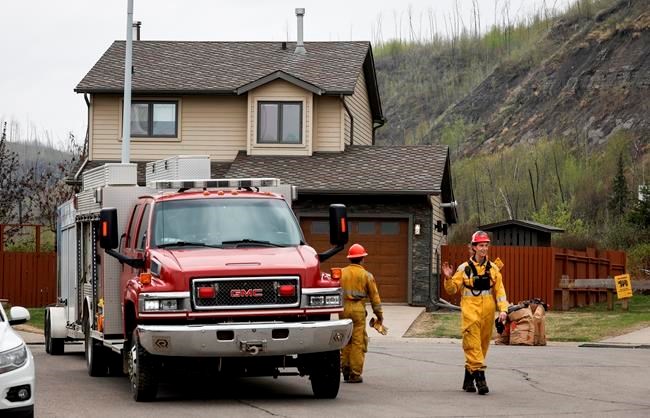FORT MCMURRAY, Alta. ŌĆö The oilsands hub city of Fort McMurray, Alta., got a watery reprieve from a menacing wildfire Thursday as steady rain fell and water cannons delivered a soaking blast to tinder-dry ditches.
Alberta Wildfire information officer Christie Tucker said the blaze remained out of control ŌĆō the only such designated fire in the province ŌĆō but it did not grow overnight and remained at about 200 square kilometres in size.
ŌĆ£WeŌĆÖre seeing rain and cooler temperatures in much of the province this week, but unfortunately the northern part of the province is expected to stay drier and warmer,ŌĆØ Tucker told a news conference in Edmonton.
The blaze was still just under six kilometres from the southwest outskirts of the community and less than five kilometres from the main highway south.
The fire forced 6,600 residents in four neighbourhoods to leave their homes Tuesday.
Jody Butz, the regionŌĆÖs fire chief, said crews hoped to leverage the wetter, cooler weather to get a good grip on the fire.
ŌĆ£We're gracious with Mother NatureŌĆÖs kindness,ŌĆØ Butz told reporters.
ŌĆ£We'll take as much rain as we can get.ŌĆØ
Butz added, ŌĆ£Some of you may be wondering if the rain in the forecast changes the date to return home to evacuated neighbourhoods. That date still remains the same."
Evacuated residents have been told they may be able to return after the long weekend. The rest of the city ŌĆö about 61,000 residents ŌĆö and other surrounding subdivisions remained under an evacuation alert.
Not far from most minds in Fort McMurray has been the 2016 wildfire, nicknamed The Beast, that forced out the entire community and torched more than 2,400 homes.
On Thursday, the city's court system was temporarily shut down and schools were closed. Some remaining residents said they have food and drinks stored away in case of a longer, larger evacuation.
But grocery stores were open and well stocked, with an abundance of toilet paper.
Restaurants, many of which closed Tuesday, reopened.
"We closed down for the initial day, just so all of our staff could look after their families," said Shelby Thompson of Montana's BBQ and Bar.
"We opened the next day," Thompson said. "Regular hours."
At the city's Peter Pond Mall, there was initial confusion about Tuesday's evacuation order and stores shut their doors, said Shauna Hannam, the mall's specialty leasing manager.
Many employees, fearing a repeat of the citywide evacuation eight years ago, "rushed to get ahead of the game," she said.
"For a lot of people, it was history repeating itself: 'I'm just going to get my family out of here right now.'
"The next day, when half the city wasn't evacuated, that's when the confusion set in. People weren't sure whether they were going to work."
Slowly, they are. Hannam said more than half the mall's stores were open Thursday.
Other fires across Western Canada have also forced residents out of their homes.
In northern British Columbia, a blaze threatening Fort Nelson had grown to almost 30 square kilometres but was heading away from town. The community of 4,700 remained under an evacuation order.
Rob Fraser, the mayor of the Northern Rockies Regional Municipality, said some structures were damaged on rural properties outside Fort Nelson. He did not say how many or if they included homes.
Cooler temperatures and higher humidity were expected to help firefighters over the coming days. Fraser said there was no timeline for when evacuees might return.
"We don't want to be in that situation where we turn people back to the community and three days later we just send them out again," Fraser said. "That would be just a nightmare."
In Manitoba, 675 people have been forced out of the area in and around the northwestern community of Cranberry Portage. There was no word on when they might be able to return.
The province said the fire remained less than two kilometres from the community. Power and phone service have been restored.
The Manitoba and federal governments announced Thursday a deal to spend a combined $38.4 million over four years to boost firefighting and prevention.
The money, to be split evenly, is aimed at buying more firefighting equipment, boosting training, and increasing the number of skilled wildland firefighters and other staff.
This report by The 91įŁ┤┤ Press was first published May 16, 2024.
Bob Weber, The 91įŁ┤┤ Press



